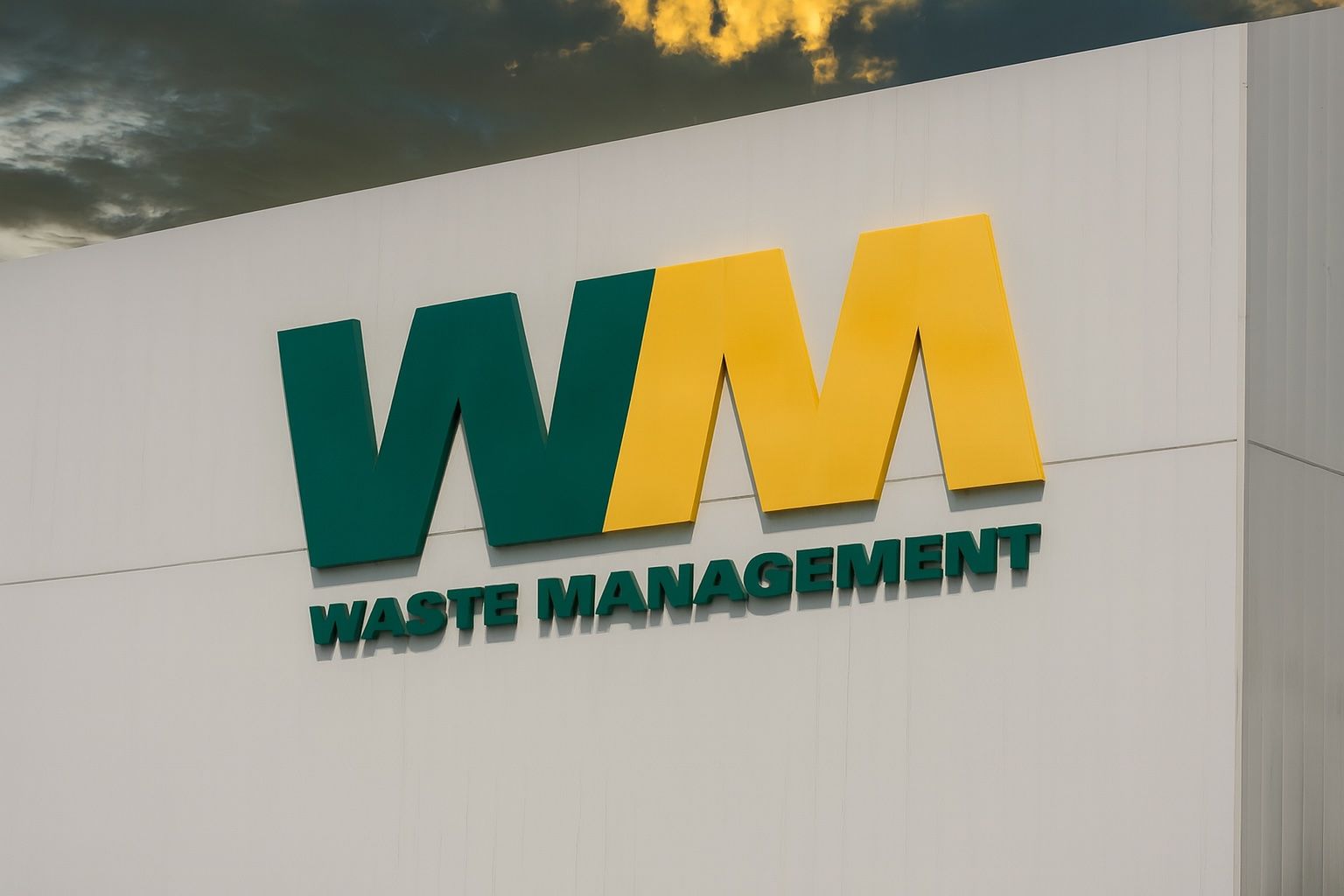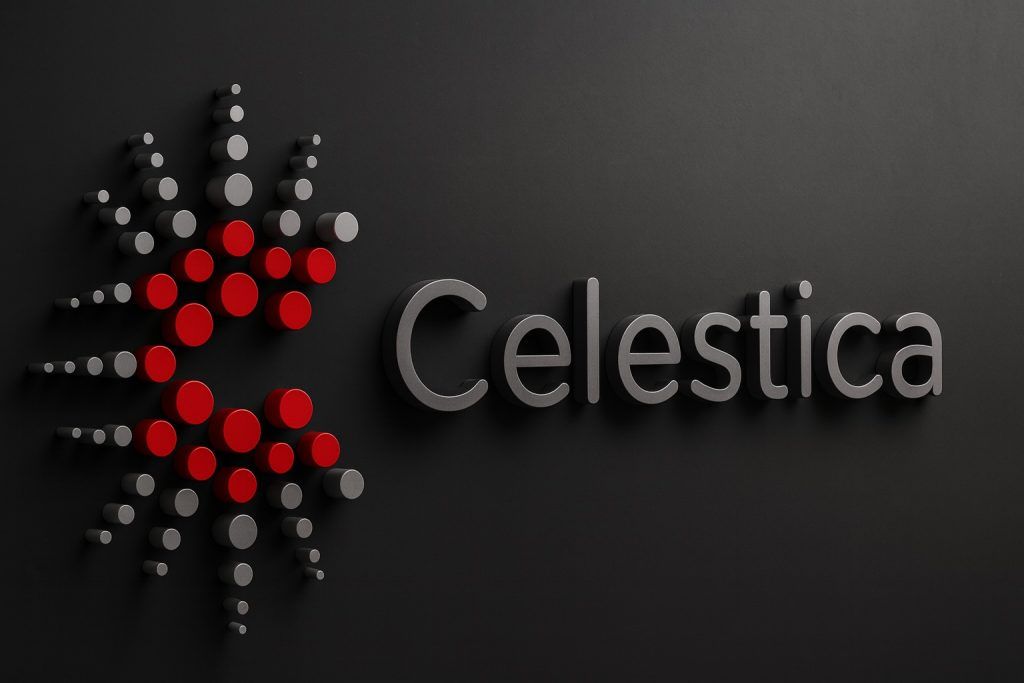- Stock Price Update: Waste Management’s stock (NYSE: WM) traded around $213–$215 per share on October 27, 2025, dipping roughly 2% in after-hours trading following its latest earnings release [1]. The stock is up about 6–7% year-to-date, lagging the broader market rally, but has delivered nearly 400% total return over the past decade (about 17% annualized) [2].
- Q3 Earnings Missed Estimates: WM reported third-quarter 2025 net income of $603 million (EPS of $1.49), or $1.98 per share on an adjusted basis [3]. This was slightly below analyst consensus of ~$2.01–$2.03, and revenue of $6.44 billion also came in a bit under the ~$6.49B expected [4] [5]. Still, revenue grew a robust 14.9% year-on-year (from $5.61B) thanks in part to acquisitions [6].
- Record Margins & Cash Flow: Despite the headline miss, operating profitability hit record levels. WM’s core collection and disposal business achieved an adjusted EBITDA margin of 38.4%, a company record [7]. Through the first nine months, operating cash flow jumped 12% (to $4.35B) and free cash flow rose 13.5% (to $2.11B) year-over-year [8], underscoring strong underlying cash generation.
- Guidance Trimmed on Recycling Weakness: The company maintained full-year profit guidance (adjusted EBITDA of $7.48–$7.63B and free cash flow of $2.8–$2.9B) [9]. However, it trimmed its 2025 revenue outlook to roughly $25.28 billion, the low end of prior guidance, citing slumping recycled commodity prices and slightly lower-than-hoped revenue from its new healthcare (medical waste) division [10]. Commodity recycling sales fell as average prices for recycled materials plunged nearly 35% vs. last year, a significant headwind [11].
- Recent Company Moves: Waste Management completed a $7.2 billion acquisition of Stericycle in late 2024, expanding aggressively into medical and hazardous waste services [12]. This WM Healthcare Solutions segment (bolstered by Stericycle’s assets) is now contributing to growth, but management noted “modestly lower revenue expectations” in that unit this quarter [13]. The Stericycle deal positioned WM as the leader in regulated medical waste, and CEO Jim Fish touted it as adding a “complementary business platform” with attractive growth prospects in medical waste and secure information destruction [14].
- Analyst Sentiment & Targets: Wall Street remains cautiously optimistic on WM. Analysts’ consensus rating is a “Buy”, with about 13 out of 21 analysts rating it Buy or Strong Buy versus 8 Holds and none recommending a sell [15]. The average 12-month price target is around $250–$255, implying ~15–20% upside from current levels [16]. Recent analyst moves include Jefferies cutting its target to $244 (from $268) while maintaining a Buy rating, and UBS trimming to $240 (from $265) with a Neutral stance [17] [18]. Price targets generally cluster in the mid-$240s to upper-$260s, indicating confidence in WM’s resilience despite near-term headwinds.
- Sector & ESG Angle: Waste Management is the largest waste services company in North America and a popular pick for ESG-focused investors. The company has invested roughly $3 billion in recent years to upgrade recycling facilities and develop renewable natural gas (RNG) projects at its landfills [19]. Peers like Waste Connections (WCN) and Republic Services (RSG) also saw solid demand – WCN, for example, beat its Q3 estimates with revenue of $2.46B vs $2.42B expected and adjusted EPS $1.44 vs $1.37 [20]. However, WM’s scale and sustainability investments (from fleet electrification to capturing landfill methane for fuel) position it as an industry leader in “green” initiatives. As one analysis noted, WM’s pivot into healthcare waste and renewable energy “creates a moat in high-margin, regulated markets, while its steady cash flows and dividend track record offer defensive appeal” [21].
Stock Price and Recent Movements
Waste Management’s stock has been trading in the low-$200s per share in late October. It closed at $213.71 on October 27, 2025 [22], just before the company released earnings. Immediately after the results, WM shares slipped about 2% in post-market trading [23] as investors digested the revenue and earnings miss. Despite this dip, the stock remains modestly higher for 2025 (up roughly 6–7% year-to-date) [24], reflecting the broader market’s strength this year. By comparison, the Dow Jones Industrial Average hit record highs in October amid robust corporate earnings and easing inflation, which has lifted many industrial stocks.
It’s worth noting that WM has a history of steady value creation: over the past ten years the stock delivered nearly 400% in total returns, far outpacing the S&P 500 index [25]. This long-term growth has been driven by the company’s stable business model – underpinned by recurring trash collection contracts, price escalators tied to inflation, and expansion into higher-value services. In 2023–2024, WM’s share price had flattened out relative to high-growth sectors (partly due to rising interest rates making defensive dividend stocks slightly less attractive), but volatility in WM stock is generally low. Many investors view it as a defensive holding: demand for waste services tends to be steady through economic cycles, providing a “durable” business with high margins and reliable cash flow [26].
Recent trading range: WM shares have traded between roughly the low $200s and mid-$220s in recent weeks (the stock’s 52-week high is around that upper range). The slight pullback going into the earnings may have reflected cautious sentiment about the quarterly results. In fact, in the weeks prior, several analysts lowered price targets for WM (without changing ratings), citing near-term concerns like cost inflation and commodity price weakness [27]. For example, between October 6–16, at least five research firms – including UBS, Morgan Stanley, BMO, Raymond James, and Barclays – all trimmed their targets by a few percentage points (to the $232–$271 range) while maintaining Neutral/Overweight ratings [28] [29]. These moves signaled tempered expectations, which appear to have been warranted given the slight earnings miss.
Nonetheless, waste industry stocks broadly have been stable performers lately. Waste Connections (WCN), the third-largest industry player, reported its earnings a few days before WM and slightly beat expectations, suggesting that solid waste demand remains healthy [30]. And while Republic Services (RSG) (the second-largest hauler) hadn’t released Q3 results as of Oct. 27, it garnered headlines earlier in the month when workers (Teamsters union) won a new labor deal after a nationwide sanitation strike [31]. The quick resolution of that strike eased fears of service disruptions in the sector. Overall, even as WM’s stock saw a modest post-earnings dip, its peer group and the broader industrial sector have been on an upswing, supported by a mix of strong economic activity and investor rotation into defensive, cash-generative businesses.
Q3 2025 Earnings Highlights
Waste Management’s third-quarter 2025 earnings, announced after the market close on Oct. 27, were a mixed bag: solid growth and profitability, but just shy of Wall Street’s forecasts. The company reported net income of $603 million for Q3, which is $1.49 per share in earnings [32]. On an adjusted basis (excluding one-time items), earnings were $1.98 per share, up from the year-ago period but a few cents below the $2.01–$2.03 consensus estimate [33] [34]. This marked a rare miss for WM, which had generally met or exceeded estimates in recent quarters.
Revenue for the quarter came in at $6.44 billion, a sizable 14.9% increase year-over-year [35]. The top-line growth was driven largely by WM’s expanded footprint in 2025 – notably the inclusion of Stericycle’s medical waste operations (acquired late last year) and robust pricing in its core trash collection business. In fact, WM achieved about 6.0% higher core pricing on collection and disposal services (with 3.8% “yield” from pure price increases) [36], demonstrating its pricing power even as volumes in some segments were flat. This pricing, combined with cost discipline and synergies, boosted profitability: adjusted operating EBITDA rose to $1.86 billion for the legacy business, and the collection & disposal unit’s margin hit a record 38.4% [37] – meaning the company kept well over a third of each revenue dollar in operating profit, an impressive margin for an industrial service firm.
However, both revenue and EPS fell slightly short of analyst expectations (revenue missed by about $50–60 million, or <1%) [38]. The earnings shortfall was roughly 3 cents per share. According to the Associated Press report, “the results did not meet Wall Street expectations” [39], as analysts surveyed had expected a bit stronger numbers. This is partly attributable to external headwinds in the quarter:
- Recycling Drag: WM’s recycling division faced a significant slump in commodity prices. The company noted that blended prices for recycled materials (like paper, cardboard, metals) were down almost 35% from a year ago [40]. This led to a $60 million year-over-year revenue decline in the Recycling business [41], offsetting some growth elsewhere. Lower prices for things like cardboard or scrap metal mean WM earns less revenue when it sells those recovered materials, a challenge affecting the entire recycling industry recently amid global commodity gluts.
- Medical Waste Integration: While the Stericycle acquisition has provided a new growth avenue (medical and hazardous waste services), WM indicated that revenues in its WM Healthcare Solutions segment were a bit softer than initially hoped this quarter [42]. CEO Jim Fish pointed to “modestly lower revenue expectations” from that segment in Q3, which contributed to management cutting the full-year revenue outlook. Some analysts believe this could be a short-term issue as WM integrates the Stericycle business – cross-selling to healthcare clients and optimizing routes takes time. Nonetheless, the long-term thesis for buying Stericycle was to tap into a higher-margin niche (regulated medical waste) that rides secular trends like aging populations and increased healthcare activity [43]. In Q3, the integration is still underway, and any minor revenue lag there is something investors will watch in coming quarters.
On the positive side, traditional waste operations remained strong. Collection and disposal (trash pickup, landfills, transfer stations) is WM’s bread-and-butter, and it saw organic revenue growth thanks to the above-mentioned pricing gains and steady volumes. The company also benefited from internal efficiencies – for example, it has been investing in automation (such as optical sorters in recycling plants and route optimization software for its trucks) which helps control costs. These efficiency moves contributed to WM’s 8.7% growth in adjusted operating EBITDA for the legacy business [44] even on more modest volume growth, indicating margin expansion.
In the earnings press release, CEO Jim Fish struck an upbeat tone despite the misses. “Our third quarter results highlight momentum in WM’s earnings growth and free cash flow conversion, driven by our strong operating platform, diverse and growing customer base, and expanding sustainability businesses,” Fish said [45]. In other words, management is emphasizing that the underlying business – including newer ventures like sustainability services – is performing well and generating cash, even if commodity swings created a short-term drag.
Market reaction: Investors initially reacted to the earnings with some caution (hence the ~2% after-hours stock drop). A slight miss and trimmed revenue forecast typically spark some profit-taking. However, many analysts and long-term shareholders appear focused on the fact that WM’s core fundamentals remain solid: profit margins are at record highs, cash flow is growing double-digits, and the company is successfully passing on price increases to customers. These factors suggest that the Q3 miss was due more to transient issues (recycling prices, etc.) than any systemic problem in demand for WM’s services.
Guidance and Company Updates
Alongside its Q3 results, Waste Management updated guidance for the full year 2025. The company now expects full-year revenue of approximately $25.275 billion [46]. This is slightly lower than previous guidance (which had topped out around $25.5B) and essentially aligns with the “low end” of the prior range [47]. The downward tweak is directly tied to the factors discussed: continued weakness in recycled commodity markets and a modest shortfall in the healthcare/medical waste unit’s growth. Even at $25.3B, WM’s revenue would be roughly +15% higher than 2024’s, thanks largely to the Stericycle acquisition boosting the top line [48].
Importantly, profitability guidance was reaffirmed. WM maintained its full-year adjusted operating EBITDA outlook of $7.475–$7.625 billion, and its free cash flow forecast of $2.8–$2.9 billion [49]. Holding these targets steady implies that, despite slightly lower revenue, the company has managed costs well enough (or seen margins a bit better) such that earnings are not expected to suffer. It also indicates confidence that the fourth quarter will proceed as planned. For context, hitting the midpoint of the EBITDA guide would mark about a 10% increase in operating profit versus last year, a healthy gain.
WM’s ability to meet its cash flow and earnings goals in a tough commodity environment highlights the resilience of its business model. Much of the company’s revenue comes from long-term contracts with municipalities, businesses, and industrial clients. These contracts often have fuel surcharge mechanisms and index-based pricing that allow WM to adjust charges based on inflation or commodity prices, buffering the impact of cost swings [50]. For example, when fuel prices rose earlier, WM was able to pass on those costs to customers through surcharges. Now, as recycling prices fall, the core trash collection contracts (which make up the majority of revenue) are still bringing in steady, inflation-adjusted cash. This contractual pricing power is one reason management and analysts remain confident in WM’s ability to hit its profit targets even if certain revenue streams underperform.
On the company update front, the Stericycle integration remains a focal point. The $7.2B acquisition (closed in November 2024) gave WM a leading position in the medical waste disposal and document destruction markets [51]. Over the past year, WM has been folding Stericycle’s operations into its own, rebranding them under WM Healthcare Solutions. According to Waste Management, this move is strategically important: medical waste services carry high barriers to entry (strict regulation, specialized facilities like incinerators) and thus higher margins. WM’s CEO Jim Fish stated that “this acquisition provides a complementary business platform in medical waste, a sector with attractive near- and long-term growth dynamics” [52]. The idea is that WM can cross-sell these services to existing customers (e.g. a hospital that already uses WM for general waste might add on Stericycle’s regulated medical waste pickup). Through the first half of 2025, integration was on track – by Q1, WM Healthcare Solutions contributed meaningfully to EBITDA and saw cost synergies in SG&A (selling, general & admin) expenses [53] [54]. In Q3, while revenue was a tad light, there’s no indication of any deal misstep; rather, it’s likely timing and market conditions (some hospitals may be producing slightly less waste or optimizing services).
Another area of update is WM’s sustainability and environmental initiatives. The company has heavily promoted its investments in recycling and renewable natural gas (RNG) projects. WM is converting landfill methane into pipeline-quality gas that can be sold as renewable fuel, an endeavor boosted by environmental credits and the low-carbon fuel standards in states like California [55]. In Q3, management noted continued expansion of these projects – for instance, new RNG processing facilities have come online at certain landfills. Even though RNG credit prices have been volatile (down about 14% in early 2025 vs 2024 levels, which could affect revenues modestly [56]), WM views this as a long-term growth platform that turns trash into energy revenue. Likewise, WM is upgrading its recycling centers with automation (optical sorters, robotics) to improve efficiency. These moves not only potentially lower costs and increase throughput, but also bolster WM’s image as an ESG (environmental, social, governance) leader. In fact, the company often highlights that it’s turning “waste into a resource,” aligning with circular economy trends.
From a regulatory perspective, there haven’t been major new regulations in the past few days affecting WM, but the industry always keeps an eye on policies. For instance, any changes to environmental regulations, landfill permitting, or recycling mandates can influence business. Currently, trends like stricter recycling requirements or bans on certain waste (e.g. food waste bans in landfills) can create new service opportunities for WM. Additionally, the regulatory push for lower carbon emissions benefits WM’s RNG projects by providing credits and incentives [57]. Investors are also watching the potential renewal or adjustment of renewable energy tax credits at the federal level (like those in the Inflation Reduction Act), which could affect the economics of landfill gas projects. So far, WM’s guidance incorporates the existing regulatory framework, and no abrupt changes are on the horizon as of late October.
Broad market factors are also part of the backdrop for WM’s outlook. The company operates a capital-intensive business (lots of trucks, equipment, landfills), so interest rates and financing costs matter – the recent high-rate environment means WM’s debt servicing is a bit more expensive, but the company’s balance sheet remains solid and its credit ratings strong. Inflation in wages and fuel can squeeze margins, yet WM has navigated this via pricing power as mentioned. Meanwhile, the overall U.S. economy in 2025 has shown resilience; continued economic growth and construction activity generally mean more waste volume to collect (new buildings, consumer spending = more trash). The flip side is if there were a recession, waste volumes, especially industrial/commercial, could dip. Right now, however, economic signals are fairly positive, and WM’s guidance implies a stable demand environment.
Lastly, it’s notable that WM’s dividend and buyback programs remain intact as part of its shareholder return strategy. The company has a 25+ year streak of annual dividend increases [58], making it a reliable income stock. Its current dividend yield is around ~1.5–1.7%, which, while not high, is viewed as very secure given the cash flow. WM also occasionally repurchases shares; no major new buyback was announced this quarter, but the company has been using excess cash to reduce debt from the Stericycle deal and will likely resume more aggressive buybacks once leverage normalizes.
In summary, WM’s updated guidance and recent moves paint a picture of a company that had a slight stumble on revenues, but is still on a strong footing financially. The focus is now on executing in Q4 – especially improving the recycling pricing where possible (largely out of their control) and continuing to integrate Stericycle to unlock its full revenue potential. WM’s leadership appears confident that these are manageable issues. By holding profit guidance steady and emphasizing cost controls, the message is that the long-term growth story (driven by higher-value services and operational excellence) is intact.
Analyst Commentary and Long-Term Outlook
Analysts covering Waste Management stock generally remain positive about its trajectory, balancing short-term caution with confidence in the company’s defensive qualities and growth investments. Consensus forecasts compiled by financial platforms show that the average 1-year price target for WM is in the mid-$250s per share [59] – roughly 15–20% above the current market price. This suggests analysts see upside as the company works through current headwinds. As of late October, around 20–22 analysts follow WM, with a consensus rating in the “Buy” range [60] [61]. Notably, none have a Sell rating, reflecting the view that downside risk is limited by WM’s stable cash flows and industry dominance.
Several equity research notes over the past weeks have offered insight into what experts are watching:
- Jefferies (Buy, PT $244) – The Jefferies team recently lowered their price target from $268 to $244 ahead of earnings [62], citing macro factors like higher interest rates and some near-term earnings risk, but they maintained a Buy rating. They reportedly emphasized WM’s strong competitive position and pricing power, opining that the stock’s recent pullback could be a buying opportunity for long-term investors as waste volumes and pricing normalize.
- UBS (Neutral, PT $240) – UBS analysts trimmed their target from $265 to $240 in mid-October [63], taking a more cautious stance. They remain Neutral, pointing to concerns about recycled commodity volatility and potential integration hiccups with Stericycle. However, even UBS acknowledges the company’s fundamental solidity; their Neutral is more about valuation after WM’s stock had a decent run-up earlier in the year. At ~$240, even the cautious case sees some upside.
- Barclays (Overweight, PT $271) – Barclays in early October reiterated an Overweight (essentially a bullish rating) and has one of the higher targets at $271 [64] [65]. Their analysis suggests WM will continue to benefit from “structurally higher margins” and the tailwinds of the Stericycle deal going into 2026. In a research note, Barclays highlighted WM’s success in expanding EBITDA margins above 30% and saw the recent dip in share price as overdone. As per a Nasdaq summary, Barclays’ outlook implies about 20% upside and they note the average peer target is around $261 [66].
- Oppenheimer (Outperform, PT $262) – Oppenheimer’s analyst Noah Kaye also remains bullish (rating Outperform) and adjusted his target slightly from $265 to $262 after seeing industry trends [67] [68]. He argues that WM is a “best-in-class operator” and that its moves into RNG and medical waste will drive above-industry growth. Kaye does caution that investors need patience as those investments ramp up, but he believes WM’s defensive characteristics (steady waste volumes, regulated pricing) justify a premium valuation.
Looking beyond the next quarter, the consensus expectation is that WM will continue to churn out mid-single-digit revenue growth and double-digit earnings growth. According to StockAnalysis estimates, analysts project WM’s revenue will rise about 5–6% in 2026 (to ~$27.6B) and EPS will grow ~12% (from ~$7.78 in 2025 to ~$8.73 in 2026) [69] [70]. These forecasts incorporate further benefits from the Stericycle integration (e.g. cost synergies and cross-selling boosting margins) and the assumption that recycling prices eventually stabilize from current lows. In essence, while 2025 saw an unusually large revenue jump (~18% expected, mostly from the acquisition [71]), 2026 should see a more normalized growth path but still healthy, with WM leveraging its broader service portfolio.
Expert commentary also often touches on WM’s role as an ESG play and an economic barometer. Some market commentators note that WM sits at the intersection of infrastructure and sustainability. For example, a recent analysis by The AInvest highlighted that “WM is transforming its narrative… now positioning itself as a leader in high-growth adjacent markets—healthcare waste and renewable natural gas—while fortifying its financial moat through synergies and operational discipline” [72]. This speaks to the company’s strategy of extending beyond traditional trash hauling into businesses with strong environmental angles and higher margins. By doing so, WM aims to future-proof its growth – participating in the renewable energy boom via landfill gas, and in the healthcare sector via medical waste management, all while its core trash business continues to throw off cash. This multi-pronged approach is why many analysts consider WM not just a staid utility-like stock, but rather a “defensive ESG play with upside” [73].
In interviews and commentary, WM’s management has expressed confidence about the long run. CEO Jim Fish often notes that as communities grow and consumption increases, waste generation will rise, but more critically, the complexity of waste management is increasing – from recycling electronics to safely disposing of medical sharps – and WM is positioning itself as the go-to solutions provider for all such needs. The company’s scale (it operates hundreds of landfills, recycling centers, and now medical waste facilities) is a significant competitive advantage. It also invests heavily in technology (like routing software and sustainability tracking tools) which smaller competitors might struggle to afford. These factors lead many analysts to view WM’s moat as widening over time, supporting consistent earnings and dividend growth.
Risks and caveats: Of course, no outlook is without risks. Some experts caution about a few potential issues that could temper WM’s stock performance in the medium term:
- If inflation or fuel costs were to spike unexpectedly, it could pressure margins until surcharges catch up.
- A sharp economic downturn would likely reduce industrial/commercial waste volumes (those are the more cyclical parts of WM’s business, versus residential trash which is very steady). This could slow revenue growth.
- Integration of acquisitions, while going well so far, always carries execution risk. WM made a very large bet on Stericycle; if the expected synergies or growth don’t materialize, investors might question the price paid. However, so far synergy realization is on track (WM targeted ~$80–$100M in 2025 cost synergies from Stericycle, and initial reports show SG&A savings contributing a noticeable margin bump [74] [75]).
- Regulatory shifts: on one hand WM benefits from pro-environment policies, but on the other, if regulations ever limited landfilling or imposed heavy new costs (e.g. higher landfill taxes or required expensive technology), that could impact profitability. The company has navigated such changes for decades and often helps shape industry-friendly regulations, but it’s something to watch.
In the bigger picture, most analysts and industry observers maintain that Waste Management’s prospects are solid. The waste disposal industry tends to be “slow and steady” – it’s not going to grow at tech-like rates, but it’s very reliable. WM itself has proven adept at squeezing out growth via price increases, efficiency gains, and bolt-on acquisitions. Additionally, WM’s commitment to returning cash to shareholders (through dividends and buybacks) makes it attractive for long-term holders like pension funds and foundations (indeed, Bill Gates’s foundation famously holds a large stake in WM) [76]. This supportive shareholder base and institutional interest provide stability to the stock.
Bottom line: As of late October 2025, Waste Management stock appears to be in a consolidation phase – digesting the recent earnings news and the huge Stericycle deal from last year. The near-term sentiment is neutral to mildly positive: the Q3 miss and guidance trim have been largely priced in, and investors are now looking ahead to see if Q4 (and the holiday season, which often generates extra waste volume) can give a final boost to hit year-end targets. Meanwhile, the long-term outlook remains upbeat. The consensus among experts is that WM’s unique blend of defensive stability and ESG-oriented growth initiatives will drive continued value. With analysts forecasting double-digit earnings growth into 2026 [77] and the stock trading at a reasonable valuation (~15–16 times forward earnings [78]), many see the recent dip as an opportunity. As one market strategist put it, “Trash is cash,” and Waste Management’s ability to turn the necessities of waste disposal into a profitable, sustainable enterprise makes it a stock to watch for both income and growth investors going forward.
Sources:
- Associated Press via MarketScreener – Waste Management Q3 Earnings Snapshot [79] [80] [81]
- Investing.com – WM stock moves 2% lower after missing Q3 estimates [82] [83] [84]
- TS2.tech Daily Market News – Waste Management (WM): A Long-Term Cornerstone for Portfolios [85] [86]
- Waste Dive – WM completes $7.2B Stericycle deal… (CEO quote on acquisition rationale) [87]
- MarketScreener News – Analyst target updates (Jefferies, UBS, etc.) [88] [89]; Peer earnings (WCN beat) [90]
- StockAnalysis – Analyst consensus and forecasts for WM [91] [92]
- AInvest (analysis platform) – Building a Sustainable Moat in Healthcare and Renewables [93] [94]
References
1. www.investing.com, 2. ts2.tech, 3. www.marketscreener.com, 4. www.marketscreener.com, 5. www.investing.com, 6. www.investing.com, 7. www.investing.com, 8. www.investing.com, 9. www.investing.com, 10. www.investing.com, 11. www.investing.com, 12. ts2.tech, 13. www.investing.com, 14. www.wastedive.com, 15. stockanalysis.com, 16. stockanalysis.com, 17. www.marketscreener.com, 18. www.marketscreener.com, 19. ts2.tech, 20. www.marketscreener.com, 21. www.ainvest.com, 22. finance.yahoo.com, 23. www.investing.com, 24. stockanalysis.com, 25. ts2.tech, 26. ts2.tech, 27. www.marketscreener.com, 28. www.marketscreener.com, 29. www.marketscreener.com, 30. www.marketscreener.com, 31. www.marketscreener.com, 32. www.marketscreener.com, 33. www.marketscreener.com, 34. www.investing.com, 35. www.investing.com, 36. www.investing.com, 37. www.investing.com, 38. www.marketscreener.com, 39. www.marketscreener.com, 40. www.investing.com, 41. www.investing.com, 42. www.investing.com, 43. www.wastedive.com, 44. www.investing.com, 45. www.investing.com, 46. www.investing.com, 47. www.investing.com, 48. ts2.tech, 49. www.investing.com, 50. ts2.tech, 51. www.wastedive.com, 52. www.wastedive.com, 53. www.ainvest.com, 54. www.ainvest.com, 55. www.ainvest.com, 56. www.ainvest.com, 57. www.ainvest.com, 58. www.ainvest.com, 59. stockanalysis.com, 60. stockanalysis.com, 61. stockanalysis.com, 62. www.marketscreener.com, 63. www.marketscreener.com, 64. stockanalysis.com, 65. stockanalysis.com, 66. www.nasdaq.com, 67. stockanalysis.com, 68. stockanalysis.com, 69. stockanalysis.com, 70. stockanalysis.com, 71. stockanalysis.com, 72. www.ainvest.com, 73. www.ainvest.com, 74. www.ainvest.com, 75. www.ainvest.com, 76. www.nasdaq.com, 77. stockanalysis.com, 78. www.ainvest.com, 79. www.marketscreener.com, 80. www.marketscreener.com, 81. www.marketscreener.com, 82. www.investing.com, 83. www.investing.com, 84. www.investing.com, 85. ts2.tech, 86. ts2.tech, 87. www.wastedive.com, 88. www.marketscreener.com, 89. www.marketscreener.com, 90. www.marketscreener.com, 91. stockanalysis.com, 92. stockanalysis.com, 93. www.ainvest.com, 94. www.ainvest.com








